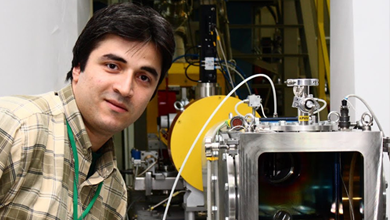Direction:Particle Physics
Position:Associate Professor
Juansher Jejelava entered the Tbilisi State University in 2000 where he defended his bachelor’s and master’s degree. In 2006, he started his PhD project at the Ilia State University in the field of particle physics. In 2011, he defended his doctoral thesis and moved from theory to phenomenology. Since 2012, he has been in collaboration with the ATLAS/CERN as a part of TileCal Signal Reconstruction Group. In 2016, Dr. Jejelava joined the ATLAS SUSY group, to which he belongs until now. At the same time, he keeps working on some projects in high energy physics theory.
Along with university duties, he acted as a trainer or a team leader in international competitions for secondary school students such as ‘International Young Physicists tournaments’ in 2017, International Physics Olympiads in 2009 and 2010, International Zhautikov Olympiad 2012, and in a couple more.
In 2015, he participated at the FameLab competition at CERN, and as the finalist, received an extensive media training from the BCC.
Since 2013, he has kept a small scientific blog to popularize science.
In 2018, together with his former group mate from the University, he started the first entertaining scientific PodCast in the Georgian language.
Scientific interests / research interests
Lorentz Violation; Tensor Field Gravity; Yang-Mills Theories; SUSY; Machin Learning; Multivariable Analysis;
Featured Publications
- J. L. Chkareuli and J. G. Jejelava, “Spontaneous Lorentz Violation: Non-Abelian Gauge Fields as Pseudo-Goldstone Vector Bosons,” Phys. Lett. B 659 (2008) 754 [arXiv:0704.0553 [hep-th]].
- J. L. Chkareuli, C. D. Froggatt, J. G. Jejelava and H. B. Nielsen, “Constrained gauge fields from spontaneous Lorentz violation,” Nucl. Phys. B 796 (2008) 211 [arXiv:0710.3479 [hep-th]].
- J. L. Chkareuli, J. G. Jejelava and G. Tatishvili, “Graviton as a Goldstone boson: Nonlinear Sigma Model for Tensor Field Gravity,” Phys. Lett. B 696 (2011) 124 [arXiv:1008.3707 [hep-th]].
- J. Jejelava, ”Comparison of Different Reconstruction Methods with the PulseSimulator”, https://cds.cern.ch/record/1976207/files/ATL-COM-TILECAL-2014-086.pdf (for ATLAS internal circulation, only).
- M. Aaboud et al. [ATLAS Collaboration], “Search for direct top squark pair production in final states with two leptons in arXiv:1708.03247 [hep-ex].
- J. L. Chkareuli, J. Jejelava and Z. Kepuladze, “Lorentzian Goldstone modes shared among photons and gravitons,” arXiv:1709.02736 [hep-th].
Articles in magazines
http://georgianscience.blogspot.com/
An extensive list of publications
Since 2014 in ATLAS AUTHOR LIST
Current Courses |
Course Catalog |
|---|---|
| Bachelor’s level
Master’s level
Bachelor’s level
Master’s level
|
2020-2021 Year Bachelor’s level
Master’s level
2019-2020 Year Bachelor’s level
Master’s level
2018-2019 Year Bachelor’s level
Master’s level
2017-2018 Year Bachelor’s level
Master’s level
2015-2016 Year Bachelor’s level
2014-2015 Year Bachelor’s level
2013-2014 Year Bachelor’s level
2012-2013 Year Bachelor’s level
2011-2012 Year Bachelor’s level
2010-2011 Year Bachelor’s level
2009-2010 Year Bachelor’s level
|

